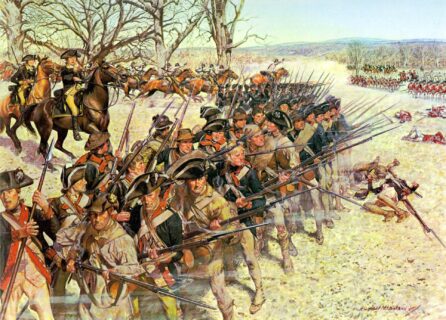
245th Anniversary of Lexington and Concord
The story is one of the most familiar in American history. Though shrouded in myth, the details are well-known. In the overnight hours of April 18-19, 1775, British regulars staggered from their bunks, donned their red wool uniforms, were rowed across the Charles River, and marched through the Massachusetts countryside. Their goal was the destruction of military supplies believed hidden in Concord by the colonial militia. With a little luck, the British also hoped to arrest two of the nascent rebellion’s most belligerent leaders, Sam Adams and John Hancock. Throughout the long night, church bells rang, guns fired, and a trio of riders alerted the colonists that British troops were on the move. The warnings enabled Adams and Hancock to escape capture while the rebel defenders of Massachusetts, having left their warm beds, prepared to guard their towns.
This was not the first time Massachusetts militiamen had faced British troops in the field. As recently as February of 1775, a similar early morning march advanced on Salem. That stand-off did not end in gunfire. This time, the result would be different and make something of a prophet of beleaguered King George III, who claimed in November of 1774 that since “the New England governments are in a state of rebellion, blows must decide, whether they are to be subject to this country or independent.”[1]
When the British column approached Lexington, approximately six miles east of Concord, townspeople, mustered on the village lawn, confronted the troops. Militia Captain John Parker shouted to his men, “Don’t fire unless fired upon. But if they want war, let it begin here.”[2] Shots were exchanged, resulting in casualties on both sides. The militia, intimidated by British bayonets, withdrew, so the British column marched on to Concord, where they burned the few supplies they found. The colonists had taken advantage of the early warning to hide their stash in new locations.
Before the day was out, war was what the British got. Minutemen flooded the woods and farms adjacent to the road to Boston. Hiding behind trees, fences, or in farmhouses, they harassed the troops throughout the twenty-mile march back to Boston. “Even weamin had firelocks,” reported one bewildered British sea captain.[3] In February of 1775, the Earl of Sandwich had dismissed the colonists as “raw, undisciplined, cowardly men.”[4] Raw and undisciplined they were, but the day proved to any British officer who dared to pay attention that the Americans were not cowardly. They kept up a steady peppering for nearly twenty miles, striking down approximately 250 British soldiers with their sniping. British troops abandoned clothing, weapons, and ammunition in exchange for a chance to escape with their lives.
In the immediate aftermath of the fighting, both sides hustled to get their account of the battles into the public record. One of these early accounts was a letter, dated April 20, 1775, from Boston merchant John Andrews to his brother-in-law, William Barrell of Philadelphia. Andrews gets some details wrong, but his account captures the essence of the events. He describes the effectiveness of the colonial warning system before the British advance, the need for British reinforcements to rescue the endangered column retreating toward Boston, and the inherent difficulty of getting accurate information from the field. News of the events in Lexington and Concord must have traveled quickly for Andrews to have time to compile his account just one day after the encounter. Fear of the event’s significance must have been rising rapidly as well. Andrews told his brother-in-law: “When I reflect and consider that the fight was between those whose parents but a few generations ago were brothers, I shudder at the thought, and there’s no knowing where our calamities will end.”[5] Andrews intuitively understood that a rebellion against Great Britain would be a civil war: bitter, bloody, and unpredictable.
John Andrews’s account is part of an upcoming Core Document Collection volume from the Ashbrook Center. Entitled, The American Revolution, edited by Robert M. S. McDonald. The collection contains forty-four documents on the revolutionary era along with other resources to help teachers guide students in an in-depth study of the topic. The American Revolution tells the story in the words of those who lived it, from the roots of the imperial crisis in the 1760s to the ultimate denouement in 1783.
John Andrews’ Account of the Battles of Lexington and Concord
We have included in this post an audio reading of the document and its introduction:
[1] Correspondence of George III with Lord North, I in The Spirit of Seventy-Six, ed. Henry Steele Commager and Richard B Morris, (Castle Books, Edison NJ, 2002), p.61
[2] Commager, Henry Steele and Richard B Morris, The Spirit of Seventy-Six (Edison, NJ, Castle Books, 2002), p. 70
[3] John Crozier to Dr. Rogers, in The Spirit of Seventy-Six, ed. Henry Steele Commager and Richard B Morris, (Castle Books, Edison NJ, 2002), p.77.
[4] The Earl of Sandwich, n The Spirit of Seventy-Six, ed. Henry Steele Commager and Richard B Morris, (Castle Books, Edison NJ, 2002), p. 61
[5] https://teachingamericanhistory.org/library/document/account-of-the-battles-of-lexington-and-concord/



